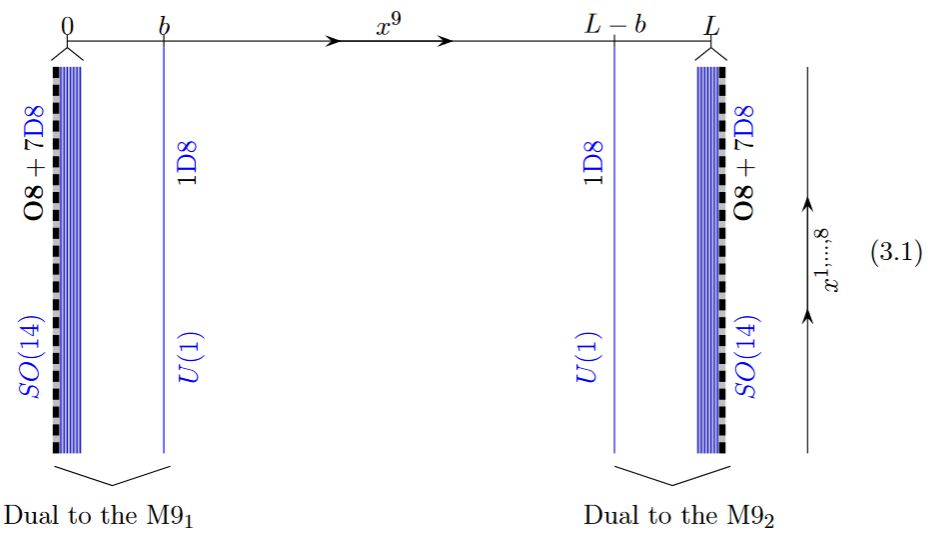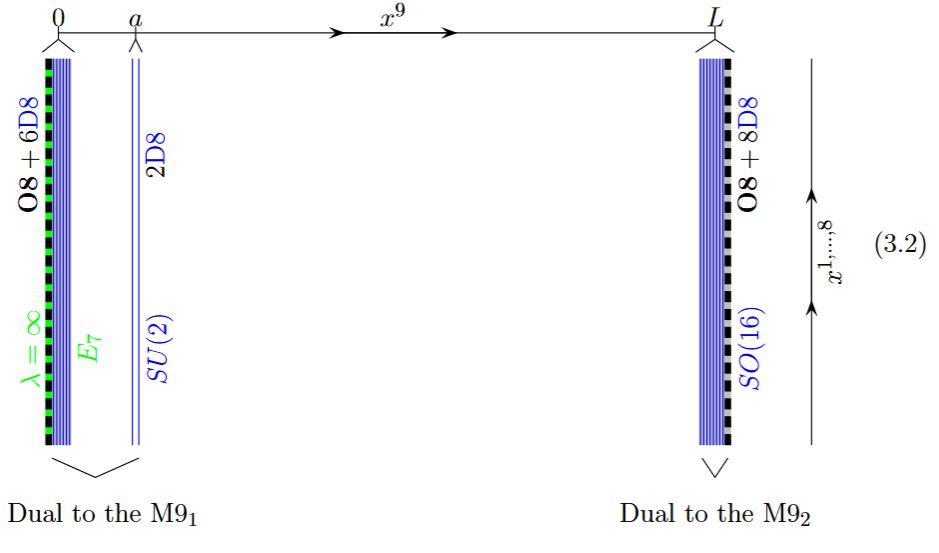nLab M9-brane
Context
String theory
Ingredients
Critical string models
Extended objects
Topological strings
Backgrounds
Phenomenology
Contents
Idea
The -orbifold/higher orientifold fixed point in Hořava-Witten theory might be called it O9-plane but is often called the M9-brane (e.g. GKSTY 02, section 3, Moore-Peradze-Saulina 04), even though it is on a different conceptual footing than the genuine M2-brane and M5-brane.
Hull 1997, pages 8-9 argued that the M9-brane is the object whose charge is the Poincaré dual to the time-component of the M2-brane charge as it appears in the M-theory super Lie algebra via
(Analogously, the time component of the M5-brane charge is argued to be dual to the charge of the KK-monopole, see there.)
Under the duality between M-theory and type IIA string theory the M9-brane may be identified with the O8-plane:

from GKSTY 02, section 3
This may be used to understand the gauge enhancement to E8-gauge groups at the heterotic boundary of Horava-Witten theory:

from GKSTY 02, section 3
Related concepts
Table of branes appearing in supergravity/string theory (for classification see at brane scan).
References
Early discussion of the possibility of a kind of 9-brane in 11d supergravity:
-
Mike J. Duff, p. 28 of: Supermembranes, TASI lectures (1996) [arXiv:hep-th/9611203]
-
Paul S. Howe, Ergin Sezgin, p. 9 in: Superbranes, Phys. Lett. B 390 (1997) 133-142 [arXiv:hep-th/9607227, doi:10.1016/S0370-2693(96)01416-5]
-
Mees de Roo, p. 5 of: Intersecting branes and Supersymmetry, in: Supersymmetry and Quantum Field Theory, Proceedings of the D. Volkov Memorial Seminar Held in Kharkov, Ukraine, 5–7 January 1997, Springer (1998) [arXiv:hep-th/9703124, doi:10.1007/BFb0105225]
-
Chris Hull, Gravitational Duality, Branes and Charges, Nucl. Phys. B 509 (1998) 216-251 [arXiv:hep-th/9705162, doi:10.1016/S0550-3213(97)00501-4]
On M9-branes (and apparently introducing that terminology) as lifts of the D8-branes in massive type IIA string theory:
-
Eric Bergshoeff, Yolanda Lozano, Tomas Ortin, (4.8) in: Massive Branes, Nucl. Phys. B 518 (1998) 363-423 [arXiv:hep-th/9712115, doi:10.1016/S0550-3213(98)00045-5]
-
Eric Bergshoeff, Jan Pieter van der Schaar, On M-9-branes, Class. Quant. Grav. 16 (1999) 23-39 [arXiv:hep-th/9806069, doi:10.1088/0264-9381/16/1/002]
Further discussion:
- M. P. Garcia del Moral, P. Leon, A. Restuccia, Wordsheet description of a massive type IIA superstring in 10D [arXiv:2306.16620]
A proposal for a description of the M9 as an higher WZW theory is in
- Takeshi Sato, A 10-form Gauge Potential and an M-9-brane Wess-Zumino Action in Massive 11D Theory, Phys. Lett. B477 (2000) 457-468 (arXiv:hep-th/9912030)
Discussion of how the M2-brane and the M5-brane may arise from this by tachyon condensation is in
- Laurent Houart, Yolanda Lozano, Brane Descent Relations in M-theory, Phys.Lett. B479 (2000) 299-307 (arXiv:hep-th/0001170)
Discussion of the M9 as the dual in Horava-Witten theory of O8-planes in type II string theory is in
- E. Gorbatov, V.S. Kaplunovsky, J. Sonnenschein, Stefan Theisen, S. Yankielowicz, section 3 of On Heterotic Orbifolds, M Theory and Type I’ Brane Engineering, JHEP 0205:015, 2002 (arXiv:hep-th/0108135)
see also at Intersection of D6s with O8s
Cohomological discussion of ninebrane structures is in
- Hisham Sati, Ninebrane structures (arXiv:1405.7686)
See also
-
Paul Howe, A. Kaya, Ergin Sezgin, P. Sundell, Codimension One Branes (arXiv:hep-th/0001169)
-
Gregory Moore, Grigor Peradze, Natalia Saulina, Instabilities in heterotic M-theory induced by open membrane instantons, Nucl.Phys. B607 (2001) 117-154 (arXiv:hep-th/0012104)
-
Takeshi Sato, On M-9-branes and their dimensional reductions, Nucl. Phys. Proc. Suppl. 102 (2001) 107-112 (arXiv:hep-th/0102084)
Discussion of open M5-branes ending on the M9-brane is in
- Eric Bergshoeff, Gary Gibbons, Paul Townsend, Open M5-branes, Phys. Rev. Lett. 97:231601 2006 (arXiv:hep-th/0607193, doi:10.1103/PhysRevLett.97.231601)
Discussion as exotic branes in exceptional field theory:
- Niels Obers, Boris Pioline, U-duality and M-Theory, Phys. Rept. 318 (1999) 113-225 [arXiv:hep-th/9809039, doi:10.1016/S0370-1573(99)00004-6]
p. 109: “conjectured M9-brane which should more properly be called M8-brane.”
-
David S. Berman, Edvard T. Musaev, Ray Otsuki, Exotic Branes in Exceptional Field Theory: and Beyond, J. High Energ. Phys. 2018 53 (2018) [arXiv:1806.00430, doi:10.1007/JHEP12(2018)053]
Berman, Musaev & Otsuki (2018), p. 65: “However, as remarked in 1, [the M9 brane] should more properly be called an M8-brane or perhaps KK8 following its mass formula designation 8(1,0). It is, perhaps, to be understood as an object that exists only as a lift of the D8-brane of Type IIA.”
Last revised on September 15, 2024 at 08:18:24. See the history of this page for a list of all contributions to it.